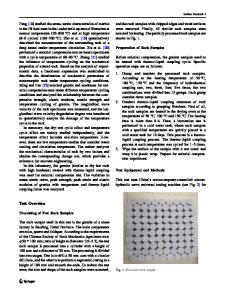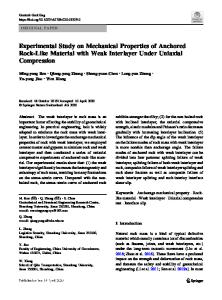Experimental Study on AE Characteristics of Granite under Uniaxial Tension at Different Strain Rates
- PDF / 1,252,498 Bytes
- 8 Pages / 595.276 x 841.89 pts (A4) Page_size
- 52 Downloads / 334 Views
691
https: //doi. org/10.1007/s11595-020-2309-2
Experimental Study on AE Characteristics of Granite under Uniaxial Tension at Different Strain Rates WANG Yan1, WANG Na1, WANG Zhaozhu1, CHEN Yuzhi2, WANG Yao2, ZHAO Haitao1
(1. College of Civil and Transportation Engineering, Hohai University, Nanjing 210024, China; 2. School of Architecture and Civil Engineering, Jinling Institute of Technology, Nanjing 211169, China)
Abstract: To investigate the acoustic emission (AE) characteristics of quasi-brittle materials like rock and concrete, and to further analyze their damage and failure mechanism under seismic and other dynamic loads, the uniaxial tension test of granite cylinder specimens within the strain rate range of 10-7-10-4 s-1 was monitored by AE technology, and the typical AE characteristic parameters were analyzed using statistical and correlation analysis. The experimental results show that, with the increase of strain rate, the peak of AE hit rate appears earlier and increases; the proportion of AE hits with higher duration or amplitude increases significantly, the b-value shows a decreasing trend, and the distribution of AE frequency-amplitude is increasingly discrete. In addition, the obvious characteristic of double dominant frequency bands was observed in AE waveforms by using spectrum analysis, with the increase of strain rate, the percentage of A-type waveforms corresponding to low dominant frequency band increases, while that of D-type waveforms corresponding to high ones decreases accordingly, which is significance for the further study of the damage and failure mechanism of quasi-brittle materials. Key words: granite; strain rate; uniaxial tension; AE characteristics; spectrum analysis
1 Introduction The AE phenomena are closely related to the internal damage of quasi-brittle materials like rock and concrete. Therefore, the analysis of AE characteristics is helpful to reveal the damage evolution law of micro-crack initiation, propagation and fracture in materials[1,2]. AE parameter analysis and waveform analysis are two basic methods to research the AE characteristics. Currently, as a more intuitive and easy-to-handle analysis method, AE parameter analysis is widely applied to evaluate the damage degree of materials. Through experimental studies under various loading conditions[3-8], the researchers have found that the cracking degree of rock-like materials can be well detected by the correlation of AE parameters with mechanical properties. Meanwhile, AE waveform analysis method has excel© Wuhan University of Technology and Springer-Verlag GmbH Germany, Part of Springer Nature 2020 (Received: June 29, 2019; Accepted: Sept.18, 2019) WANG Yan(王岩): Assoc.Prof.; Ph D; E-mail: ww2269968 @126.com Funded by the National Natural Science Foundation of China (No. 51878245) and the Fundamental Research Funds for the Central Universities (No. 2019B13114)
lent performance in signal noise recognition[9], but limited by acquisition equipment, most researches focus on the dominant frequency characteristics of
Data Loading...











